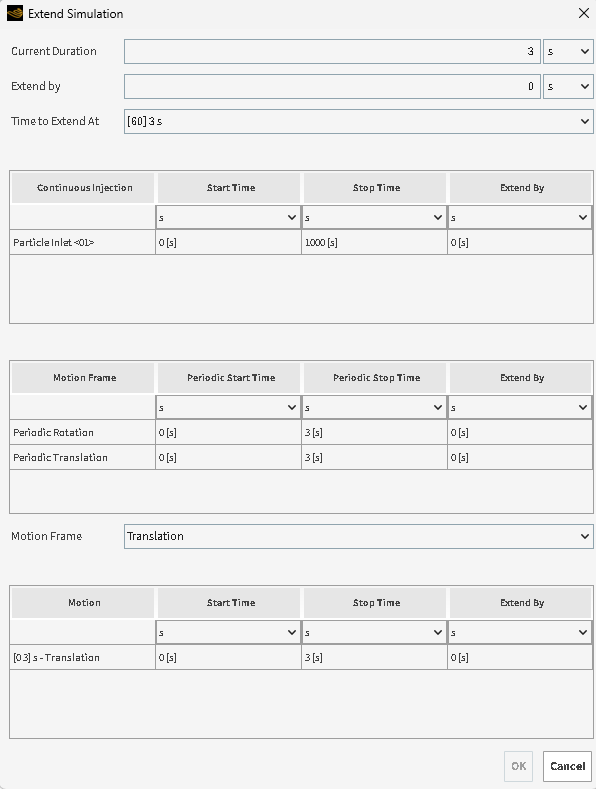If you have already started processing your simulation and discover that your Duration value was not set long enough to meet your needs, you can add more time by extending the simulation.
What would you like to do?
See Also:
If you have already started processing a simulation, no matter whether it is still in-process or has completed, extending the duration will add more seconds to the existing Duration value, and will cause the number of particles within the simulation to be recalculated accordingly.
Extending the duration also allows you to extend the particle release time for any inlets within the simulation, as well as extend any motions within the Motion Frames that you have defined.
Once you have extended the duration of your simulation, you must then Resume Processing the Simulation in order for processing to continue to the newly defined end point.
Tip: To see a walk-through example of extending the duration of your simulation, refer to the following Workshop: Tutorial - Vibrating Screen in the Rocky Tutorial Guide
Use the figure and table below to understand the various properties you can set when extending the duration of your simulation.
Table 1 : Extend Simulation dialog options
Setting | Description | Range |
|---|---|---|
Current Duration | Displays what was originally entered in the Simulation Duration text box. | Display only |
Extend by | Enables you to choose how much more simulation time you want to add onto your original Simulation Duration value. | Positive values |
Time to Extend At: | Determines the Timestep at which the simulation will continue processing when Resume is clicked on the Solver tab. By default, this displays the last saved Timestep that has been processed. If you choose an earlier Timestep from the list, then the Timesteps that follow will be re-calculated when processing resumes. Note: Changing this from the default should be necessary only if you have inlets, motions or periodic motions you want to extend the duration of that also have original Stop Times that end before the current Timestep. In these cases, to have inlets, motions or periodic motions re-calculated to include the extended time, you must change the Time to Extend At value to be less than the inlet's, motion's or periodic motion's Stop Time value. | Automatically determined |
Inlet | If you have any inlets in your simulation, the names of each inlet are listed here in separate rows. | Display only |
Start Time | Displays what was originally entered in the Start Time text box for the inlet or motion indicated. | Display only |
Stop Time | Displays what was originally entered in the Stop Time text box for the inlet or motion indicated. | Display only |
|
Motion Frame |
Lists in separate rows the names of each periodic motion that is defined in the simulation. |
Automatically determined |
|
Periodic Start Time |
Displays what was originally entered in the Periodic Start Time text box for the periodic motion indicated. |
Display only |
|
Periodic Stop Time |
Displays what was originally entered in the Periodic Stop Time text box for the periodic motion indicated. |
Display only |
Extend by | For an inlet, enables you to extend the amount of time by which particles are released from the inlet. For a motion or periodic motion, enables you to extend the amount of time the motion should occur.
Note: In order to extend an inlet's, motion's or periodic motion's time, the Time to Extend At value must be less than the inlet's or motion's Stop Time value.
| Positive values |
Motion Frame (drop-down list) | Enables you to select which Motion Frame contains the motions that you want to extend. | Automatically determined |
Motion | Lists in separate rows the names of each motion that is defined in the selected Motion Frame. | Automatically determined |
What do you want to do?
See Also:
About Inlet Parameters
From your stopped but in-process or completed simulation, on the Solver tab, click Extend.
Note: If Extend is disabled, you might need to stop your simulation first. (See also Stopping a Simulation.)
From the Extend Simulation dialog, choose the values you want, and then click OK. The Simulation Duration value on the Time tab is extended by the amount you chose.
See Also:



